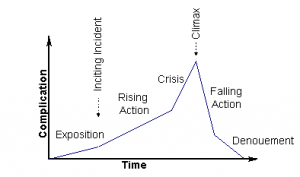 It can be intimidating to think about writing your life story. Relax. Memoir isn’t your entire life story. It’s a slice of life, not birth to death. Don’t confuse memoir with autobiography. Today the only autobiographies which find publishers are those written by presidential candidates, retired statesmen, and superstars. And typically written by authors who don’t trust biographers to paint their portrait in a flattering light.
It can be intimidating to think about writing your life story. Relax. Memoir isn’t your entire life story. It’s a slice of life, not birth to death. Don’t confuse memoir with autobiography. Today the only autobiographies which find publishers are those written by presidential candidates, retired statesmen, and superstars. And typically written by authors who don’t trust biographers to paint their portrait in a flattering light.
The classical forms of autobiography are called apologia, oration, and confession. Apologia are written as self-justifications for one’s actions. Orations are written to document one’s literary talents in description of one’s successes. And confessions are written about racy events or radical ideas with self-criticism like Augustine and Jean-Jacques Rousseau. First-person accounts which serve to protect ego, flaunt id, or appease superego misses the mark of the memoir genre. Gore Vidal described memoir as how one remembers one’s own life experiences. It is not fiction even though the genre employs many of the same literary conventions and devices.
 If you want to start writing a memoir, start by closing your eyes and draw upon those crystal clear recollections from your lifespan. Moments you can’t forget. The ones that a smell can invoke. Memories jogged by the weather, or how a garment feels, or the taste of a seasonal dish. Engage your senses in the recollection. Begin here. With one snapshot moment from the past.
If you want to start writing a memoir, start by closing your eyes and draw upon those crystal clear recollections from your lifespan. Moments you can’t forget. The ones that a smell can invoke. Memories jogged by the weather, or how a garment feels, or the taste of a seasonal dish. Engage your senses in the recollection. Begin here. With one snapshot moment from the past.
Lisa Dale Norton calls these moments “shimmering images.” Those lucid memories that you can bring into the palm of your hand and can describe in detail and depth. Select one of these moments frozen in time and put the picture into thousands of words to capture its full richness.
When you first begin to write your memoir, create rough drafts of your memories about these moments. Once you’ve written a dozen or so of these shimmering images, you can begin to see the structure of your memoir emerge in an organic manner.
 Since a memoir is intended for others to read, the writer must provide enough specifics and details that the reader can fully comprehend the memory, its import and emotional weight. Where were you? When was this? How old were you then? What else was going on? Who is present in this moment? What are their relationships to the writer and each other? What are their motives in this moment? What happened? What did you see? What did you hear? What did you smell, touch, taste? How did you react?
Since a memoir is intended for others to read, the writer must provide enough specifics and details that the reader can fully comprehend the memory, its import and emotional weight. Where were you? When was this? How old were you then? What else was going on? Who is present in this moment? What are their relationships to the writer and each other? What are their motives in this moment? What happened? What did you see? What did you hear? What did you smell, touch, taste? How did you react?
As you begin to write about these moments, spend eighty percent of your words on description. Then take your time sorting out for yourself the meaning or moral to this story. As you begin to revise and think about how these memories relate to one another, this 20% of writing about what it means will reveal the themes, plot lines, character motivations, and other clues as to the memoir’s narrative arc.
 You’ll look to organize your vignettes in alignment with points along a dramatic arc. Start with an inciting incident—when everything began to change for you—and weave backstory in along the route of escalating events. Begin with a turning point and look for a climax—when you have been transformed by the changes—to give shape to your narrative arc. Memoir is a story of personal transformation, a hero’s journey.
You’ll look to organize your vignettes in alignment with points along a dramatic arc. Start with an inciting incident—when everything began to change for you—and weave backstory in along the route of escalating events. Begin with a turning point and look for a climax—when you have been transformed by the changes—to give shape to your narrative arc. Memoir is a story of personal transformation, a hero’s journey.
Writing memoir has its own rewards. Whether you decide to publish or not, you can enjoy the tremendous benefits from putting your words to paper. Since the mid-1980s, studies have provided evidence of the value of first-person expressive writing as a way to bring about healing—measurable changes in physical and mental health. It can also positively affect people’s sleep habits, work efficiency, and social relations. Dr. James Pennebaker at the University of Texas-Austin pioneered research on the effects of expressive writing and Joshua Smyth, Ph.D., of Syracuse University has also been at the forefront with studies which demonstrate writing can boost immune functioning in patients with illnesses such as AIDS, asthma, and arthritis. The “writing to heal” movement has served adult victims of domestic violence, child abuse, and PTSD, and has been recognized as therapeutic by the American Psychological Association and Veterans Administration. You’ll feel better if you write your memoir.
 There are many reasons to write. Publishing is only one of them. Memoir has become nearly as popular a genre as fiction. The market is oversaturated and extraordinarily competitive.
There are many reasons to write. Publishing is only one of them. Memoir has become nearly as popular a genre as fiction. The market is oversaturated and extraordinarily competitive.
Almost everyone I meet thinks they have a story worth telling. And I believe them. Whether or not everyone has a story worth publishing is another matter. Consider what value your story will have for a reader who doesn’t already know you. What is your “take away” message for a reader?
Writing and publishing are two very different things. You need to write first before you can publish. But writing your story for the public may involve rewriting when you consider the ramifications of your words on those you write about and the effect it has on readers. It means going public. Your personal life goes under review and readers judge you.
As the narrator of the story, you write from your first-person point-of-view. The readers, however, judge a narrator on a variety of qualities, including how reliable you are. The narrator’s style and voice may not be self-evident to the author as distinct from the protagonist’s, but readers and editors are quick to notice when they are out sync. In memoir, the author is the narrator and the protagonist. Wearing all three hats at once makes memoir a challenge for writers because readers judge you on all three counts.
When I edit memoir manuscripts I routinely find the author has written a version of their story in which they weren’t fully cognizant of how readers might perceive them. A mother uses shopping trips or expensive vacations as the only demonstration of love towards her children. A grieving spouse immortalizes the deceased as a saint. A narrator describes every character in terms of what they wear. Co-dependent narrators who can’t see their own behavior as enabling abuse, addiction, or illness. Flirtatious dialogue with every female character when his wife is not in the scene. All were unintentional representations of self.
 As the protagonist, you are the major character in the story. You must become the hero through a series of trials and tribulations. Real life rarely follows the shape of a narrative arc; the writer shapes these experiences into a journey for the readers.
As the protagonist, you are the major character in the story. You must become the hero through a series of trials and tribulations. Real life rarely follows the shape of a narrative arc; the writer shapes these experiences into a journey for the readers.
Readers make judgments on what is written and what is left unwritten about the character of the protagonist. Audiences read between the lines to make inferences the writer may or may not have intended. The source of distortion in self-representation in memoir sometimes stems from wanting to protect someone (self, family, other characters) from part of the truth to your story.
Most successful memoir writers have been in psychotherapy for years. Critical self-reflection is an important part of the writing craft in memoir. Therapy can also be helpful during and after publication. Once the book comes out your relationships with people change. Your life is under scrutiny on so many levels.
If someone doesn’t like a character in a fictional tale, the author has no reason to take personal offense. When disparaging remarks are made about your memoir, it IS a personal attack. If your public persona as an author doesn’t match with the character description and narrative voice in your memoir, readers will find you disingenuous and inauthentic.
 Readers crave memoir to incite them to greatness. Inspire bigger selves, better selves. Those are big shoes to step into as an author.
Readers crave memoir to incite them to greatness. Inspire bigger selves, better selves. Those are big shoes to step into as an author.
If you want to publish your memoir there must be a reason grander than fame and fortune. Why do others need to hear your story? How will it serve their needs, interests, and desires? Take the “me” out your memoir manuscript if you seek publication.
Writing a memoir is not easy. Writing one that will sell and satisfy readers is an enormous challenge. Ironic as it may seem, it’s not about you. It’s about the readers.
